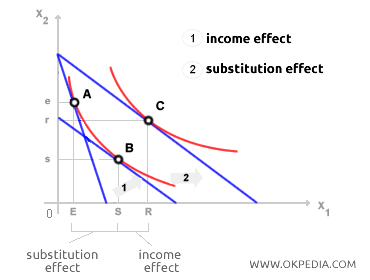Income Effect
The income effect describes how a change in a good's price impacts a consumer's buying power. When the price of a good rises, the consumer’s real income (or purchasing power) effectively decreases. Conversely, a drop in the price boosts the consumer’s real income, allowing them to purchase more. The income effect, together with the substitution effect, explains how price changes influence consumer behavior. For instance, given two goods, X1 and X2, a decrease in PX1 alters the relative price ratio of PX2 / PX1. This shift in relative prices encourages the consumer to buy more of X1, which is known as the substitution effect and is represented visually as a change in the slope of the budget line. The optimal choice shifts from the initial equilibrium point A to a temporary equilibrium point B on the same indifference curve.

However, the substitution effect is just one of the economic effects triggered by a price change in X1. Alongside the shift in relative prices, a decrease in the price of X1 also increases the consumer’s real income (the income effect), enhancing their purchasing power. With a nominal income R, the decrease in PX1 raises the consumer’s real income, which is R / P. This increase in real income moves the consumer’s budget line outward. With greater purchasing power, the consumer can afford to buy more not only of X1, which has become cheaper, but also of X2, whose price has remained the same. Adding the substitution effect to the income effect, the consumer’s choice shifts from the temporary equilibrium point B to a final equilibrium point C, reaching a higher indifference curve, which indicates an improved level of well-being for the consumer. In short, the income effect refers to the change in demand for a good, with constant relative prices, due to an adjustment in the consumer’s purchasing power. The income effect can be either positive or negative.
- Negative Income Effect. The income effect is negative when demand decreases as price rises. For instance, an increase in the price of X1 leads to a decrease in its quantity demanded. In such cases, demand drops due to both the change in relative prices (substitution effect) and the reduction in the consumer's purchasing power (income effect).
- Positive Income Effect. The income effect is positive when demand rises as the price of the good increases. For example, if the price of X1 rises, the demand for X1 (an inferior good) also increases. Although the substitution effect would typically reduce demand, since X1 is an inferior good, the decline in consumer purchasing power (real income) actually drives up demand.
- Giffen Goods. Giffen goods are a special case of a positive income effect. For these goods, the positive income effect outweighs the negative substitution effect, leading to what is known as the Giffen paradox.
 The substitution effect focuses solely on the change in relative prices without affecting the consumer’s level of well-being. The shift from point A to point B, for instance, represents a movement along the same indifference curve, maintaining the same level of welfare. In contrast, the income effect captures only the impact of increased purchasing power resulting from a decrease in the price of X1. After the income effect, the consumer’s choice shifts to a higher indifference curve, indicating a greater level of well-being due to increased purchasing power, enabling them to buy more of both goods without any change in their nominal income R.
The substitution effect focuses solely on the change in relative prices without affecting the consumer’s level of well-being. The shift from point A to point B, for instance, represents a movement along the same indifference curve, maintaining the same level of welfare. In contrast, the income effect captures only the impact of increased purchasing power resulting from a decrease in the price of X1. After the income effect, the consumer’s choice shifts to a higher indifference curve, indicating a greater level of well-being due to increased purchasing power, enabling them to buy more of both goods without any change in their nominal income R.
 Nominal vs. Real Income. It’s important to distinguish between nominal and real income. Nominal income refers to the amount of money the consumer has for spending (e.g., 1000 euros in salary). Real income, on the other hand, is the ratio of nominal income to the price level, reflecting the consumer’s actual purchasing power.
Nominal vs. Real Income. It’s important to distinguish between nominal and real income. Nominal income refers to the amount of money the consumer has for spending (e.g., 1000 euros in salary). Real income, on the other hand, is the ratio of nominal income to the price level, reflecting the consumer’s actual purchasing power.
